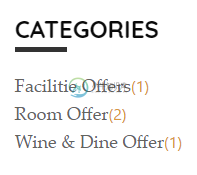在Wordpress中显示基于所选自定义分类法的自定义帖子
在我正在构建的当前网站中,我构建了以下功能。
对当前形势给予更好的理解。
有一个叫做博客的页面。此页面显示列表中的所有博客(帖子)。所有职位的类别都有一个例外。用户可以选择一个类别。一旦用户单击它,用户将转到该类别。php并查看所有具有该特定类别的帖子。
我想创建相同的场景,但不是用自定义帖子类型。我有一个模板部分;offer-list-template.php
offer-list-template.php(在这里我得到所有的报价,并显示它们);
<?php
// set up or arguments for our custom query
$paged = ( get_query_var('paged') ) ? get_query_var('paged') : 1;
$query_args = array(
'post_type' => 'Offers',
'posts_per_page' => 10,
'paged' => $paged
);
// create a new instance of WP_Query
$the_query = new WP_Query( $query_args );
?>
<?php if ( $the_query->have_posts() ) : while ( $the_query->have_posts() ) : $the_query->the_post(); // run the loop ?>
<?php
//$objectData is used in post-listing-item.php
$objectData->title = get_the_title($post);
$objectData->content = get_the_content($post);
$objectData->permalink = get_the_permalink($post);
$objectData->thumbnail = get_the_post_thumbnail($post);
$objectData->posttype = get_post_type($post);
include(locate_template('template-parts/post-listing-item.php'));
?>
<?php endwhile; ?>
在同一个文件中,有一个侧边显示类别。offer\u类别是分类法slug。
<?php $terms = get_terms( 'offer_category' );
foreach ( $terms as $term ) {
// The $term is an object, so we don't need to specify the $taxonomy.
$term_link = get_term_link( $term );
// If there was an error, continue to the next term.
if ( is_wp_error( $term_link ) ) {
continue;
}
// We successfully got a link. Print it out.
echo '<li><a href="' . esc_url( $term_link ) . '">' . $term->name . '</a><span>('. $term->count . ')</span></li>';
}
?>
</ul
结果是:

如果用户单击分类,它将转到:taxonomy offer分类。php(分类法slug.php)
在这里我需要显示帖子(post_类型-
自定义邮件类型的注册:
//Register Custom post type for Offers.
function create_posttype_offer() {
$args = array(
'labels' => array(
'name' => __('Offers', ''),
'singular_name' => __('Offer'),
'all_items' => __('All Offers'),
'add_new_item' => __('Add New Offer'),
'edit_item' => __('Edit Offer'),
'view_item' => __('View Offer')
),
'public' => true,
'has_archive' => true,
'rewrite' => array('slug' => 'Offers'),
'show_ui' => true,
'show_in_menu' => true,
'show_in_nav_menus' => true,
'capability_type' => 'page',
'supports' => array('title', 'editor', 'thumbnail'),
'exclude_from_search' => true,
'menu_position' => 70,
'has_archive' => true,
'menu_icon' => 'dashicons-star-filled'
);
register_post_type('Offers', $args);
}
add_action( 'init', 'create_posttype_offer');
// Register Custom Categoeries for Custom Post Type Offers
function taxonomies_offer() {
$labels = array(
'name' => _x( 'Categories', 'taxonomy general name' ),
'singular_name' => _x( 'Category', 'taxonomy singular name' ),
'search_items' => __( 'Search Categories' ),
'all_items' => __( 'All Categories' ),
'parent_item' => __( 'Parent Category' ),
'parent_item_colon' => __( 'Parent Category:' ),
'edit_item' => __( 'Edit Category' ),
'update_item' => __( 'Update Category' ),
'add_new_item' => __( 'Add New Category' ),
'new_item_name' => __( 'New Category' ),
'menu_name' => __( 'Categories' ),
);
$args = array(
'labels' => $labels,
'hierarchical' => true,
);
register_taxonomy( 'offer_category', 'offers', $args );
}
add_action( 'init', 'taxonomies_offer', 0 );
当我使用默认的帖子类型和调用类别时。包含以下代码的php将显示带有所选类别的帖子。但对于自定义的帖子类型,我找不到管理它的方法。
<?php if (have_posts() ) : while ( have_posts() ) : the_post(); // run the loop ?>
<?php
//$objectData is used in post-listing-item.php
$objectData->title = get_the_title($post);
$objectData->content = get_the_content($post);
$objectData->permalink = get_the_permalink($post);
$objectData->thumbnail = get_the_post_thumbnail($post);
$objectData->posttype = get_post_type($post);
include(locate_template('template-parts/post-listing-item.php'));
?>
<?php endwhile; ?>
这是后列表项(视图)
<article class="post-item">
<figure>
<?php echo $objectData->thumbnail ?>
</figure>
<div class="content">
<a href="<?php echo $objectData->permalink ?>">
<h2><?php echo $objectData->title ?></h2>
</a>
<p><?php echo $objectData->content ?></p>
<div class="read-more-button">
<a href="<?php echo $objectData->permalink ?>">read more
<span>
<svg class="next-arrow"><use xlink:href="#next-arrow" /></svg>
</span>
</a>
</div>
</div>
</article>
共有2个答案
我找到了!
我从url中获得了分类法和段塞,并在查询中使用了它。
<?php
$term_slug = get_query_var( 'term' );
$taxonomyName = get_query_var( 'taxonomy' );
$the_query = new WP_Query( array(
'post_type' => 'offers',
'tax_query' => array(
array (
'taxonomy' => $taxonomyName,
'field' => 'slug',
'terms' => $term_slug,
)
),
));
?>
<ul>
<?php while($the_query->have_posts()) : $the_query->the_post(); ?>
<li><a href="<?php the_permalink(); ?>"><?php the_title(); ?></a></li>
<?php endwhile; wp_reset_query(); ?>
</ul>
通过理解,您必须有一个查询,以便通过以下代码加载所有自定义分类法post:
$terms = get_terms(
array(
'taxonomy' => 'offer_category',
'hide_empty' => false,
)
);
foreach ($terms as $term){
$args = array(
'post_type' => 'Offers',
'tax_query' => array(
array(
'taxonomy' => 'offer_category',
'field' => 'slug',
'terms' => $term->slug,
),
),
);
$query = new WP_Query($args);
if($query->have_posts()): while($query->have_posts()): $query->the_post();
the_title();
the_content();
endwhile;
wp_reset_postdata();
endif;
}
希望这对你有用
-
我创建了一个自定义的帖子类型(书),然后为这个特定的帖子类型创建了一个自定义分类法(book_cat)。它工作正常,但如果我单击仪表板中的所有书籍页面,则没有列显示已将书籍分配给哪些类别(book_cat)(如果有)。我需要点击每本书编辑并看到那里。 注册新职位类型功能是: 分类法是:
-
更新2添加名称作为字段,而不是段塞,并添加the_title()只需给我一个页面标题的回声... 更新Jonnhyd23的代码非常有效!!谢谢有没有一种方法可以使术语变得动态?就像标题是阿姆斯特丹一样,我能做一些类似于
-
我是新来的wordpress, im创建一个自定义职位与字段的custom_meta_box(位置,着装) 所以在我的自定义帖子列表中,我想查看我在custom_meta_box上创造的价值。 这是我目前的代码:
-
我有一个自定义的帖子类型设置,有许多类别和子类别。 我试图做的是创建一个页面,显示特定类别中的所有帖子,并使用一个菜单列出所有类别子类别,以便可以过滤帖子。 我已尝试复制存档模板并将其重命名为分类法-(我的自定义分类法)。php,如果我转到slug,它会显示某些帖子,并使用
-
我目前正在从事WordPress杂志主题的研究,我想知道最好的方法 1。根据卷和问题(例如,第1卷第1期、第1卷第2期或第1卷第3期)对文章(自定义文章类型)进行排序 2。在主页上显示当前版本(例如,第1卷第3期) 到目前为止我所做的 1。我使用链接在一起的ACF创建了一个自定义分类法(卷和问题)和一个自定义字段类型(分类法)。使用下面的代码,我能够显示分类法中的所有帖子,无论它们是在第1卷第1期
-
我正在我的Wordpress公文包网站上工作,并为我的公文包部分创建了一个自定义帖子类型。当用户单击my portfolio链接时,会将他们带到archive-portfolio.php,其中显示我所有项目的图库;当用户单击项目时,会将他们带到single-portfolio.php,其中显示关联的项目。 一切都正常工作,样式正确,但现在我想让archive-portfolio.php上的gall

